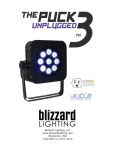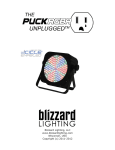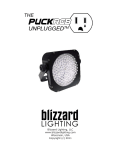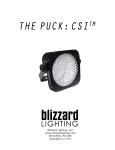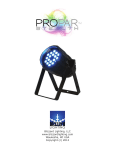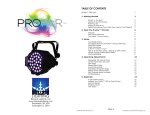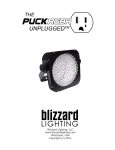Download Blizzard The Puck 3NX User manual
Transcript
Blizzard Lighting, LLC www.blizzardlighting.com Wisconsin, USA Copyright (c) 2011-2012 TABLE OF CONTENTS The Puck 3NX™ LED PAR Can 1 1. Getting Started 3 What’s In The Box? Getting It Out Of The Box Powering Up! Getting A Hold Of Us Safety Instructions (Don’t Stick Your Hand In The Toaster!) 2. Meet The Puck 3NX™ LED PAR Can 5 Features DMX Quick Reference (3 and 6-Channel Modes) The Puck 3NX™ Pin-up Picture 3. Setup 5 5 6 7 Fuse Replacement Connecting A Bunch Of Puck 3NX™ LED PAR Cans Data/DMX Cables 4. Operating Adjustments 7 7 7 8 DMX Mode & DMX Mode Selection Master/Slave Mode Sound Active Mode Custom Color Display Fixture running hour display Additional Operating Help Using the Fixture With The wiCICLE® Wireless DMX System Troubleshooting 5. Appendix 8 8 8 9 9 9 10 12 13 A Quick DMX Lesson Keeping The Puck 3NX™ LED PAR Can As Good As New Returns (Gasp!) Shipping Issues Tech Specs The Puck 3NX Manual Rev. A 3 3 3 3 4 Page 2 13 14 14 14 15 Copyright (c) 2011-2012 Blizzard Lighting, LLC 1. GETTING STARTED What’s In The Box? • • • • 1 x Puck 3NX™ Flat LED PAR Fixture 1x Mounting Bracket & 2 Knobs 1x IEC Power Cord This Eloquently Written User Manual Getting It Out Of The Box Congratulations on purchasing the next generation of our best-selling fixture ever! We’ve completely redesigned the Puck3 to provide more output, more reliability and more features, all at the same great price! Now that you’ve got The Puck 3NX™ (or hopefully, Pucks!), you should carefully unpack the box and check the contents to ensure that all parts are present and in good condition. If anything looks as if it has been damaged in transit, notify the shipper immediately and keep the packing material for inspection. Again, please save the carton and all packing materials. If a fixture must be returned to the factory, it is important that the fixture be returned in the original factory box and packing. Powering Up! All fixtures must be powered directly off a switched circuit and cannot be run off a rheostat (variable resistor) or dimmer circuit, even if the rheostat or dimmer channel is used solely for a 0% to 100% switch. AC Voltage Switch - Not all fixtures have a voltage select switch, so please verify that the fixture you receive is suitable for your local power supply. See the label on the fixture or refer to the fixture’s specifications chart for more information. A fixture’s listed current rating is its average current draw under normal conditions. Check the fixture or device carefully to make sure that if a voltage selection switch exists that it is set to the correct line voltage you will use. Warning! Verify that the voltage select switch on your unit matches the line voltage applied. Damage to your fixture may result if the line voltage applied does not match the voltage indicated on the voltage selector switch. All fixtures must be connected to circuits with a suitable Ground (Earthing). Getting A Hold Of Us If something is wrong, just give us a call or send an email. We’ll be happy to help, honest. Blizzard Lighting W220 N1531 Jericho Ct. Suite E, Waukesha, WI 53186 USA [email protected] www.blizzardlighting.com 866.493.6025 The Puck 3NX Manual Rev. B Page 3 Copyright (c) 2011-2012 Blizzard Lighting, LLC SAFETY INSTRUCTIONS • Please keep this User Guide for future use. If you sell the unit to someone else, be sure that they also receive this User Guide. • ALWAYS make sure that you are connecting to the proper voltage, and that the line voltage you are connecting to is not higher than that stated on the decal or rear panel of the fixture. • This product is intended for indoor use only. • To prevent risk of fire or shock, do not expose fixture to rain or moisture. • Make sure there are no flammable materials close to the unit while operating. • The unit must be installed in a location with adequate ventilation, at least 20in (50cm) from adjacent surfaces. Be sure that no ventilation slots are blocked. • ALWAYS disconnect from the power source before servicing or replacing fuse and be sure to replace with same fuse size and type. • ALWAYS secure fixture using a safety chain. NEVER carry the fixture by its cord. Use its carrying handles. • DO NOT operate at ambient temperatures higher than 104°F (40°C). • In the event of a serious operating problem, stop using the unit immediately. NEVER try to repair the unit by yourself. Repairs carried out by unskilled people can lead to damage or malfunction. Please contact the nearest authorized technical assistance center. Always use the same type spare parts. • NEVER connect the device to a dimmer pack. • Make sure the power cord is never crimped or damaged. • Never disconnect the power cord by pulling or tugging on the cord. • Avoid direct eye exposure to the light source while it is on. Caution! There are no user serviceable parts inside the unit. Do not open the housing or attempt any repairs yourself. In the unlikely event your unit may require service, please contact Blizzard Lighting at [email protected]. The Puck 3NX Manual Rev. A Page 4 Copyright (c) 2011-2012 Blizzard Lighting, LLC 2. MEET The Puck 3NX™ Flat LED PAR Can CONTROL FEATURES • • • • • • • Superior color mixing via 9x 3-watt TRI-Color LEDs Variable electronic strobe Variable electronic dimmer Built-in automated programs via DMX and master/slave Built-in sound active programs Full color mixing in standalone and master/slave RGB Dimming (3-Channel) and extended (6-Channel) DMX modes ADDITIONAL FEATURES • Lighter and brighter than the original! • Durable acrylic lens protector for added LED protection • 4-Button LED control panel for easy programming • Light source: 9x 3-watt TRI-Color Edison Edixeon LEDs • Dual bracket for flexibility in mounting • Power outlet for fixture linking (MAX 3A @ 120VAC) • Ultra-quiet fan for cool operation all night long • wiCICLE® Enabled functionality allows plug-and-play operation with our wiCICLE® Brand Wireless DMX system DMX Quick Reference (6-Channel Mode) Channel What It Does 1 Red Intensity 2 Green Intensity 3 Blue Intensity 4 Color Chase (slow <-> fast) 5 Strobe (0-15 off, 16-255 strobe slow <-> fast) 6 Dimmer DMX Quick Reference (3-Channel Mode) Channel What It Does 1 Red Intensity 2 Green Intensity 3 Blue Intensity The Puck 3NX Manual Rev. B Page 5 Copyright (c) 2011-2012 Blizzard Lighting, LLC Figure 1: The Puck 3NX™ Pin-Up Picture Super Fly TRI-Color LEDs Dual Mounting Yokes Acrylic Lens Protector Flat as a pancake! Figure 2: The Rear Connections DMX In DMX Out AC Power In/Out LED Control Panel Microphone The Puck 3NX Manual Rev. A Page 6 Copyright (c) 2011-2012 Blizzard Lighting, LLC 3. SETUP Fuse Replacement With a flat head screwdriver, wedge the fuse holder out of its housing. Remove the damaged fuse from its holder and replace with exact same type fuse. Insert the fuse holder back in its place and reconnect power. Connecting A Bunch of The Puck 3NX™ Flat LED PAR Cans You will need a serial data link to run light shows using a DMX-512 controller or to run shows on two or more fixtures set to sync in master/slave operating mode. The combined number of channels required by all the fixtures on a serial data link determines the number of fixtures the data link can support. Fixtures on a serial data link must be daisy chained in one single line. Also, connecting more than 32 fixtures on one serial data link without the use of a DMX optically-isolated splitter may result in deterioration of the digital DMX signal. The maximum recommended cable-run distance is 500 meters (1640 ft). The maximum recommended number of fixtures on a serial data link is 32 fixtures. Data/DMX Cabling To link fixtures together you’ll need data cables. You should use datagrade cables that can carry a high quality signal and are less prone to electromagnetic interference. For instance, Belden© 9841 meets the specifications for EIA RS-485 applications. Standard microphone cables will “probably” be OK, but note that they cannot transmit DMX data as reliably over long distances. In any event, the cable should have the following characteristics: 2-conductor twisted pair plus a shield Maximum capacitance between conductors – 30 pF/ft. Maximum capacitance between conductor & shield – 55 pF/ft. Maximum resistance of 20 ohms / 1000 ft. Nominal impedance 100 – 140 ohms The Puck 3NX Manual Rev. B Page 7 Copyright (c) 2011-2012 Blizzard Lighting, LLC 4. OPERATING ADJUSTMENTS NOTE: After making any adjustment, hold the <MENU> button for approximately 3 seconds, otherwise the fixture will return to the correct mode after approximately 10 seconds. DMX Mode Allows the unit to be controlled by any universal DMX controller. Addr 1.) The default mode for the fixture is DMX, which appears as on the LED Readout. Use the <ENTER> button then the <UP> and <DOWN> buttons to choose a channel between 1 and 512. Press <ENTER> again to confirm. 2.) To change between 3 and 6 channel DMX mode, select <ENTER>. Select either firm. ChNd, then press 6Ch or 3Ch, then press <ENTER> again to con- Master/Slave Mode (Auto/Sound Active/Color Preset/Custom): Allows you to link up to 32 units together without a controller. 1.) Use standard DMX cables to daisy chain your units together via the DMX connector on the rear of the units. 2.) Choose a unit to function as the Master. Select MAST. The master unit must be the first unit. Finally, chain the units together using DMX cable. Master SLNd NASt then to confirm. 3.) Select slave function by using the <UP>/<DOWN> keys to reach SLAV in the Master/Auto menu on the slave units, and they will react in the same as the Master. Slave SLNd SLAu then to confirm. STBY NOTE: Fixtures in slave mode will display “ “ (Standby). This is NORMAL. Return the fixture to master mode to use it as a standalone fixture. 4.) On the master fixture, use the <UP>/<DOWN> keys to reach SHND, which allows you to select the Master/Slave mode. Sound active Auto mode Color preset Fade Mode SoUn CoLo CoLo FAdE then <ENTER> to confirm. then then then Auto, then <ENTER> to confirm. CoL 1 - CoL 7, <ENTER>. SP 1 - SP 8, <ENTER>. NOTE: Speed 1 = Fastest (Approx. 1.5 sec. per color), Speed 8 = Slowest (Approx. 2 min. per color). The Puck 3NX Manual Rev. A Page 8 Copyright (c) 2011-2012 Blizzard Lighting, LLC To set a custom color in Master/Slave / Standalone Mode: Using this function, you can select any color by adjusting the Red, Green and Blue values from 0-255. You may also adjust the color balance of the fixture. Please note that modifying the values in this step will affect ALL modes, therefore we recommend resetting all levels to their highest value (255) after using this mode. NAnu from the control panel, then hit <ENTER>. 2.) Choose rEd, GrEE, or bLuE, then hit <ENTER> to confirm. 1.) Select 3.) Using the <UP>/<DOWN> keys, select the color you wish to display by varying Red/Green/Blue intensity between 0 and 255, then hit <ENTER> to confirm each color choice. 4.) Select Color preset mode as instructed above, then select CoL 7. then <ENTER> to confirm. To Show the Fixture Running Hours: 1.) Select FhrS from the control panel, then hit <ENTER> to confirm. Stuck? Want More Information? Check out our helpful tutorial video HERE: http://youtu.be/xVKhmV-v0jA That should tell you everything you need to know! The Puck 3NX Manual Rev. B Page 9 Copyright (c) 2011-2012 Blizzard Lighting, LLC USING THIS FIXTURE WITH THE wiCICLE® WIRELESS DMX SYSTEM In addition to the unbridled thrill you already received the first time you plugged in your fixture, you’ll be delighted to know that This fixture also works seamlessly with our wiCICLE® Wireless DMX system, without additional power. • ONLY fixtures bearing this logo are certified for use with the wiCICLE® without external power. • Unauthorized modification and/or using the wiCICLE® with unapproved fixtures may cause damage to the wiCICLE® or fixture. UNDER NO CIRCUMSTANCES IS BLIZZARD LIGHTING RESPONSIBLE FOR ANY DAMAGE FROM SUCH OPERATION. • Fixtures bearing the above logo MUST only use cable and connectors which separate chassis/case ground from cable shielding. Cabling with the shield connected to the connector’s case/chassis may cause malfunction and damage to the wiCICLE® or fixture. • wiCICLE® transmitters have additional power requirements and therefore cannot be powered directly from the fixture. You will need to utilize the supplied AC/DC adaptor to drive wiCICLE® transmitters in your system. WE HAD THIS SPACE, SO WE FIGURED WE’D DRAW YOU A PICTURE: Antenna Housing & 1/2-wave Antenna Antenna ferrule & articulation joint Stainless Steel Housing Recessed Selector Button Status LED 3-Pin XLR Connector (Male on transmitter, Female on receiver model) The Puck 3NX Manual Rev. A Page 10 Copyright (c) 2011-2012 Blizzard Lighting, LLC Each wiCICLE® acts as both a transmitter and a receiver, depending on whether a DMX source is applied to the integral XLR connector. This is an extremely powerful feature of the system, however, it also requires 1 piece of due dilligence, and that is the removal of extraneous DMX signals from your lighting rig BEFORE proceeding. SO: BEFORE DOING ANYTHING ELSE, YOU SHOULD DISABLE ANY BUILT-IN PROGRAMS IN THE FIXTURES YOU WISH TO CONNECT AND/ OR SET THEM AS SLAVES PRIOR TO RETURNING THEM TO DMX MODE (IF APPLICABLE). Most fixtures contain a built-in automatic, sound active or custom program which is designed to operate with the fixture NOT connected to a DMX chain. Some of these programs will automatically run unless the fixture is set to slave mode. These fixtures typically sense DMX automatically and switch to DMX mode upon receiving DMX signal (our Pucks do that!) If you plug a wiCICLE® “receiver” into an autosensing fixture set as a “master, “chances are good that the wiCICLE® “receiver” will begin transmitting the master program. Most times, this is undesirable, and taking the two seconds to switch these programs off will solve a lot of ails. Got that done? Good! Then let’s proceed! 1. Plug the wiCICLE® Receiver into the “DMX IN” connector of the fixture and verify it is receiving power (the STATUS LED should illuminate.) 2. Connect the AC/DC adaptor to the the wiCICLE® Transmitter and verify it is receiving power (the STATUS LED should illuminate.) 3. Press the RECESSED SELECTOR BUTTON on the Transmitter to select the operating channel group. (The system will store this setting for future use) The 7-Color Status LED will change color to indicate the current channel group: · · · · · · · GROUP GROUP GROUP GROUP GROUP GROUP GROUP 1: 2: 3: 4: 5: 6: 7: RED GREEN YELLOW BLUE VIOLET CYAN WHITE NOTE: “GROUP” number also corresponds to the “GROUP” setting on our LightCaster™ wireless DMX Transceiver. 4. Follow the same procedure on the Receiver to select the channel group. 5. Once both the transmitter and receiver(s) are both set to the same channel group, connect the transmitter to the DMX controller or the DMX out of a fixture on your DMX chain. 6. Once a DMX signal is provided to the transmitter, the status LED will blink RED slowly until communication is established with the receiver. The status LED on the receiver(s) will flash GREEN slowly until communication is established. 7. Once the clearest channel is auto-selected, the status LEDs will blink quickly on both the transmitter and receiver. NOTE: The color of the LED DURING operation does not indicate channel group, instead it indicates whether the unit is transmitting or receiving. That’s It! The Puck 3NX Manual Rev. B Page 11 Copyright (c) 2011-2012 Blizzard Lighting, LLC Troubleshooting Symptom Solution Fixture AutoShut Off Check the fan in the fixture. If it is stopped or moving slower than normal, the unit may have shut itself off due to high heat. This is to protect the fixture from overheating. Clear the fan of obstructions, or return the unit for service. Beam is Dim Check optical system and clean excess dust/grime. Also ensure that the 220V/110V switch is in the correct position, if applicable. No Light Output Check to ensure fixture is operating under correct mode, IE sound active/auto/DMX/Etc., if applicable. Contact service for more information. Chase Speed Too Fast/Slow Check to ensure proper setup of speed adjustment. No Power Check fuse, AC cord and circuit for malfunction. Blown Fuse Check AC cord and circuit for damage, verify that moving parts are not restricted and that unit’s ventilation is not obstructed Slow Movement Verify that 220V/110V switch is in the correct position, if applicable. Also check that speed channels are set appropriately. No Response to Audio Verify that the fixture is in “Sound Active” mode. Adjust Audio Sensitivity, If Applicable. Fixture Not Responding / Responding Erraticly Make sure all connectors are seated properly and securely. Use Only DMX Cables. Install a Terminator. Check all cables for defects. Reset fixture(s). Intermittant Lamp Check lamp for properly installation. Relamp, lamp may have reached end of life. Remote Doesn’t Work Verify remote control cable is installed properly and securely. Verify remote is correct type (CA-9 or other as applicable.) Fixture Moving On Its Own Verify proper mode of operation. Is the fixture in “Auto” mode? If your problem isn’t listed, or if problems persist, please contact support: [email protected]. The Puck 3NX Manual Rev. A Page 12 Copyright (c) 2011-2012 Blizzard Lighting, LLC 5. APPENDIX A Quick Lesson On DMX DMX (aka DMX-512) was created in 1986 by the United States Institute for Theatre Technology (USITT) as a standardized method for connecting lighting consoles to lighting dimmer modules. It was revised in 1990 and again in 2000 to allow more flexibility. The Entertainment Services and Technology Association (ESTA) has since assumed control over the DMX512 standard. It has also been approved and recognized for ANSI standard classification. DMX covers (and is an abbreviation for) Digital MultipleXed signals. It is the most common communications standard used by lighting and related stage equipment. DMX provides up to 512 control “channels” per data link. Each of these channels was originally intended to control lamp dimmer levels. You can think of it as 512 faders on a lighting console, connected to 512 light bulbs. Each slider’s position is sent over the data link as an 8-bit number having a value between 0 and 255. The value 0 corresponds to the light bulb being completely off while 255 corresponds to the light bulb being fully on. DMX data is transmitted at 250,000 bits per second using the RS-485 transmission standard over two wires. As with microphone cables, a grounded cable shield is used to prevent interference with other signals. There are five pins on a DMX connector: a wire for ground (cable shield), two wires for “Primary” communication which goes from a DMX source to a DMX receiver, and two wires for a “Secondary” communication which goes from a DMX receiver back to a DMX source. Generally, the “Secondary” channel is not used so data flows only from sources to receivers. Hence, most of us are most familiar with DMX-512 as being employer over typical 3-pin “mic cables,” although this does not conform to the defined standard. DMX is connected using a daisy-chain configuration where the source connects to the input of the first device, the output of the first device connects to the input of the next device, and so on. The standard allows for up to 32 devices on a single DMX link. Each receiving device typically has a means for setting the “starting channel number” that it will respond to. For example, if two 6-channel fixtures are used, the first fixture might be set to start at channel 1 so it would respond to DMX channels 1 through 6, and the next fixture would be set to start at channel 7 so it would respond to channels 7 through 12. The greatest strength of the DMX communications protocol is that it is very simple and robust. It involves transmitting a reset condition (indicating the start of a new “packet”), a start code, and up to 512 bytes of data. Data packets are transmitted continuously. As soon as one packet is finished, another can begin with no delay if desired (usually another follows within 1 ms). If nothing is changing (i.e. no lamp levels change) the same data will be sent out over and over again. This is a great feature of DMX -- if for some reason the data is not interpreted the first time around, it will be re-sent shortly. Not all 512 channels need to be output per packet, and in fact, it is very uncommon to find all 512 used. The fewer channels are used, the higher the “refresh” rate. It is possible to get DMX refreshes at around 1000 times per second if only 24 channels are being transmitted. If all 512 channels are being transmitted, the refresh rate is around 44 times per second. In summary, since its design and evolution in the 1980’s DMX has become the standard for lighting control. It is flexible, robust, and scalable, and its ability to control everything from dimmer packs to moving lights to foggers to lasers makes it an indispensible tool for any lighting designer or lighting performer. The Puck 3NX Manual Rev. B Page 13 Copyright (c) 2011-2012 Blizzard Lighting, LLC Keeping Your Puck 3NX™ As Good As New The fixture you’ve received is a rugged, tough piece of pro lighting equipment, and as long as you take care of it, it will take care of you. That said, like anything, you’ll need to take care of it if you want it to operate as designed. You should absolutely keep the fixture clean, especially if you are using it in an environment with a lot of dust, fog, haze, wild animals, wild teenagers or spilled drinks. Cleaning the optics routinely with a suitable glass cleaner will greatly improve the quality of light output. Keeping the fans free of dust and debris will keep the fixture running cool and prevent damage from overheating. In transit, keep the fixtures in cases. You wouldn’t throw a prized guitar, drumset, or other piece of expensive gear into a gear trailer without a case, and similarly, you shouldn’t even think about doing it with your shiny new light fixtures. Common sense and taking care of your fixtures will be the single biggest thing you can do to keep them running at peak performance and let you worry about designing a great light show, putting on a great concert, or maximizing your client’s satistfaction and “wow factor.” That’s what it’s all about, after all! Returns (Gasp!) We’ve taken a lot of precautions to make sure you never even have to worry about sending a defective unit back, or sending a unit in for service. But, like any complex piece of equipment designed and built by humans, once in a while, something doesn’t go as planned. If you find yourself with a fixture that isn’t behaving like a good little fixture should, you’ll need to obtain a Return Authorization (RA). Don’t worry, this is easy. Just send an email to [email protected], and we’ll issue you an RA. Then, you’ll need to send the unit to us using a trackable, pre-paid freight method. We suggest using USPS Priority or UPS. Make sure you carefully pack the fixture for transit, and whenever possible, use the original box & packing for shipping. When returning your fixture for service, be sure to include the following: 1.) Your contact information (Name, Address, Phone Number, Email address). 2.) The RA# issued to you 3.) A brief description of the problem/symptoms. We will, at our discretion, repair or replace the fixture. Please remember that any shipping damage which occurs in transit to us is the customer’s responsibility, so pack it well! Shipping Issues Damage incurred in shipping is the responsibility of the shipper, and must be reported to the carrier immediately upon receipt of the items. Claims must be made within seven (7) days of receipt. The Puck 3NX Manual Rev. A Page 14 Copyright (c) 2011-2012 Blizzard Lighting, LLC Tech Specs! Weight & Dimensions Length 8.50 inches (215 mm) Width 3.75 inches (95.25 mm) Height 8.25 inches (210 mm) Weight 4.2 lbs (1.9 kg) Power Operating Voltage 90-230VAC, 50-60 Hertz Fuse 2A 250V Power Consumption 35W Light Source LED 9x 3-watt TRI-Color LED’s 60K hrs. Optical Beam Angle 25 degrees 29 degree field Luminous Intensity 7,160 Lux @ 1m (Full White) Red 1,550 Lux @ 1m Green 2,250 Lux @ 1m Blue 2,930 Lux @ 1m Thermal Max. Operating Temp. 104 degrees F (40 degrees C) ambient Control Protocol USITT DMX-512 DMX Channels 3 or 6 (User Selectable) Input 3-pin XLR Male Output 3-pin XLR Female Standalone, Master/Slave, Sound Active, Other Operating Modes Color Preset, Standalone color mixing Coolness Factor Leventy Billion Percent Warranty The Puck 3NX Manual Rev. B 2-year limited warranty, does not cover malfunction caused by damage to LED’s. Page 15 Copyright (c) 2011-2012 Blizzard Lighting, LLC Enjoy your product! Our sincerest thanks for your purchase! --The team @ Blizzard Lighting

















